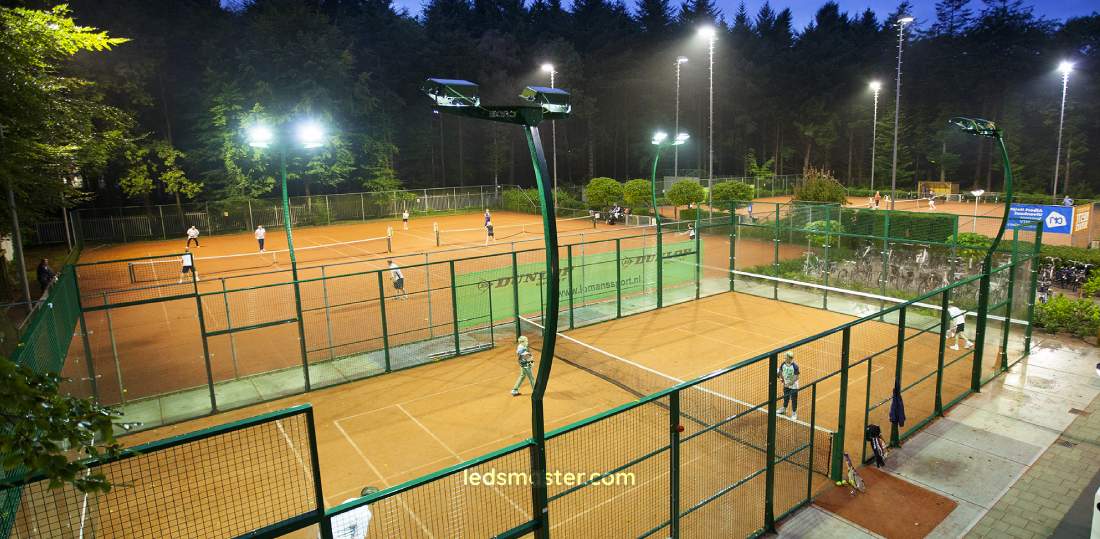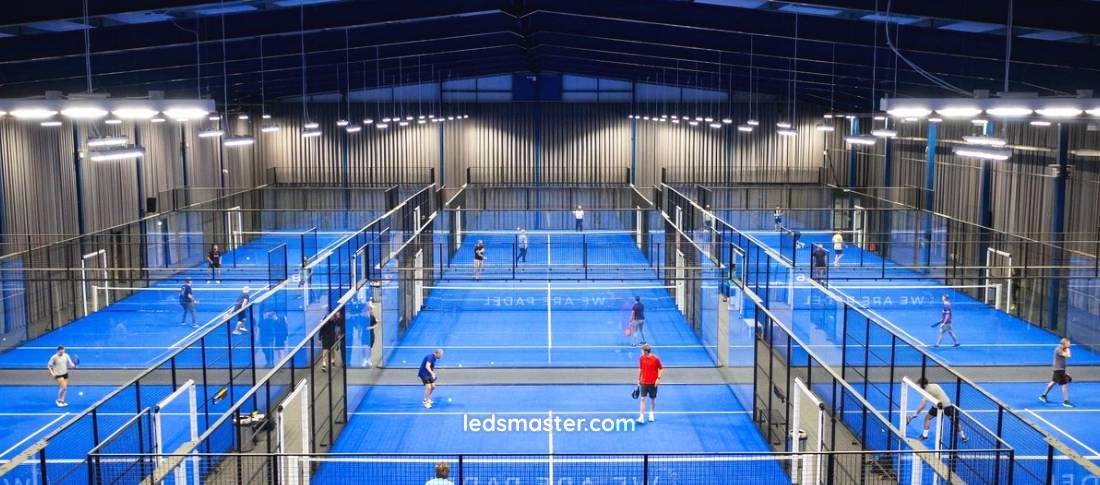Light up your padel court with our high-performance lighting system, designed to provide optimal visibility and enhance gameplay. Featuring energy-efficient LED technology, these lights offer superior brightness and uniform coverage. The robust, weather-resistant design ensures durability and longevity, making them ideal for both indoor and outdoor courts. Elevate your padel experience with our top-tier lighting solution.
Padel, a racquet sport that combines elements of tennis and squash, has grown in popularity worldwide due to its dynamic gameplay and accessibility. As the sport continues to attract enthusiasts, the importance of proper court lighting becomes paramount. High-quality lighting enhances visibility, ensures player safety, and improves the overall playing experience. This article delves into the essential aspects of padel court lighting, including lux requirements, uniformity, color temperature, and more.
Get your complimentary lighting design today
Table of Contents
ToggleLux is a unit of measurement that defines the amount of light that reaches a surface. In the context of padel courts, the recommended lux levels vary based on the skill level of the players and the specific requirements of different types of play. For recreational and amateur players, a lux level ranging from 300 to 500 is typically adequate. This level of illumination allows players to clearly see the ball and track its movement, thereby contributing to an enjoyable experience on the court.
In contrast, professional and tournament-level play necessitates higher lux levels, generally around 500 to 750 lux. These elevated lighting conditions are vital for enabling players to react swiftly and accurately, which significantly enhances the quality of the match. The differences in lux requirements highlight the varying needs of players at different skill levels and must be taken into account when designing a lighting system for padel courts.
Uniformity in lighting pertains to the even distribution of light across the entire playing surface. It minimizes shadows and glare, creating a more conducive environment for gameplay. When lighting is uneven, it can lead to areas of excessive brightness or darkness, distracting players and impeding their performance.
Achieving optimal uniformity is vital for providing a seamless visual experience. A well-designed lighting system should maintain a uniformity ratio—calculated as the ratio of the minimum to average lux levels—of at least 0.7. This balance facilitates consistent illumination throughout the court, enabling players to concentrate on the game without the distractions caused by uneven lighting.
To accomplish such uniformity, lighting fixtures specifically designed for sports applications should be utilized. These fixtures can be strategically positioned and calibrated to distribute light evenly across the playing area, thereby enhancing the overall experience for players.
Glare is a common challenge associated with sports lighting and can significantly impair visibility and cause discomfort for players. Excessive glare disrupts focus, making it challenging for players to track the ball and coordinate their movements effectively.
To combat this issue, effective lighting systems for padel courts incorporate features aimed at minimizing glare. This can be achieved through the use of fixtures equipped with specialized lenses and shields that direct light precisely where it is needed. The placement of lights at appropriate angles and heights is also vital in mitigating glare, ensuring that players remain comfortable and focused during their games.
High-quality LED lights are particularly effective in controlling glare while providing bright, consistent illumination. Moreover, the strategic design of lighting installations can significantly enhance player comfort and performance. By considering factors such as the height and direction of lighting fixtures, court designers can create an environment that minimizes visual distractions and optimizes visibility.
Color temperature, measured in Kelvin (K), describes the hue of light emitted by a fixture. For padel courts, the recommended color temperature typically ranges from 4000K to 6500K. This spectrum produces a cool white light that significantly enhances visibility and reduces eye strain.
A color temperature around 5000K is often preferred, as it strikes a balance between clarity and comfort. This range of light creates a natural daylight effect, which helps players better see the ball and their surroundings. The cool white light emitted within this spectrum aids in distinguishing colors and contrasts, particularly during fast-paced games where quick decision-making is paramount.
Selecting the appropriate color temperature is fundamental for creating an environment conducive to high-level play. It can affect how players perceive the court and the ball, ultimately influencing their performance.

Given that many padel courts are located outdoors, the durability and weather resistance of lighting fixtures become vital considerations. Outdoor lighting systems must be designed to withstand various environmental conditions, including rain, wind, and fluctuating temperatures.
High-quality lighting systems are constructed using robust materials that resist corrosion and UV radiation. This durability is crucial for ensuring that the fixtures maintain their performance over time, even in harsh conditions. A recommended standard for outdoor padel court lighting is an Ingress Protection (IP) rating of at least IP65. This rating indicates that the fixtures are dust-tight and protected against water jets, making them suitable for use in various climates throughout the year.
Investing in durable and weather-resistant lighting not only enhances the longevity of the installation but also ensures consistent performance, providing players with a reliable playing environment regardless of external conditions.
The primary aim of padel court lighting is to enhance the overall experience for both players and spectators. Well-lit courts allow for better visibility of the ball and clear perception of court boundaries, contributing to a more enjoyable game for everyone involved.
When lighting is of high quality, spectators also benefit from improved viewing conditions. This enhancement makes matches more engaging and enjoyable to watch. Furthermore, high-quality lighting can elevate the aesthetic appeal of the court, creating a professional and inviting atmosphere. This is particularly vital for venues that host tournaments and events, as the quality of lighting can leave a lasting impression on players and visitors alike.
Proper lighting not only improves visibility but also adds an element of professionalism to the court, which can help attract more players and audiences to the sport.
In addition to providing adequate illumination, energy efficiency has become a pressing concern in the design of lighting systems. As environmental awareness grows, many padel facilities are seeking sustainable solutions that reduce energy consumption without compromising performance.
LED lighting systems have emerged as a popular choice for sports applications due to their energy efficiency and longevity. Compared to traditional lighting options, LED fixtures consume significantly less energy while delivering higher levels of illumination. This reduction in energy usage not only lowers operating costs but also contributes to a more sustainable approach to sports facility management.
Moreover, integrating smart controls and automation systems can further enhance energy efficiency. These systems allow for the adjustment of lighting levels based on occupancy, time of day, and specific events. By utilizing technology to optimize energy usage, padel courts can operate more sustainably while still providing the necessary lighting conditions for competitive play.
Maintaining the lighting system is an often-overlooked aspect of ensuring a high-quality playing environment. Regular maintenance is necessary to ensure that lighting fixtures function optimally over time.
Routine inspections and cleaning of fixtures help prevent the accumulation of dirt and debris, which can diminish light output and affect visibility. Additionally, monitoring the performance of the lighting system allows for the early identification of any potential issues, ensuring that repairs can be made promptly.
Choosing durable fixtures designed for low maintenance can significantly reduce the frequency and cost of upkeep. Some modern lighting systems feature long-lasting LED bulbs that require less frequent replacement, which further contributes to the overall efficiency of the lighting solution.
Creating a well-lit padel court is not just about meeting the necessary standards; it involves a holistic approach to design that prioritizes the needs of players and spectators alike. Incorporating advanced lighting technologies, such as adjustable LED systems, can allow for tailored illumination levels that adapt to different times of day and varying weather conditions. Moreover, the integration of smart lighting solutions can enable courts to optimize energy use while enhancing the overall playing experience. For instance, sensors could automatically adjust brightness based on the number of players on the court or the ambient light conditions. This adaptability ensures that whether it’s a casual game among friends or a high-stakes tournament, the court remains a top-notch venue. Ultimately, such innovations not only elevate the quality of play but also foster a more engaging atmosphere that encourages community involvement and enthusiasm for the sport, thereby contributing to the growth and popularity of padel as a whole.
Understanding the various aspects of padel court lighting, including lux requirements, uniformity, glare control, color temperature, weather resistance, and energy efficiency, is vital for selecting the right system. While the initial investment in high-quality lighting may be substantial, the long-term benefits in terms of performance, maintenance, and player satisfaction make it a valuable addition to any padel facility.
By prioritizing effective lighting solutions, padel courts can create an optimal experience that supports the growth and enjoyment of this dynamic sport. Investing in superior lighting not only enhances the playing environment but also contributes to the overall success of padel as a popular recreational and competitive activity. With the right lighting in place, players can fully engage in the game, elevating their performance and enjoyment on the court.